 Click to learn about the significant
impact Minneapolis-St. Paul International Airport (MSP) has on the Twin Cities’ area economy.
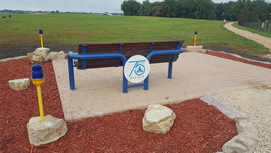 Two benches commemorating the Metropolitan Airports
Commission’s (MAC’s) 75th anniversary are now in place in an open,
park-like space off of 28th Avenue near MSP’s airfield.
Preparing and placing the benches was a
collaborative effort between the MAC’s public affairs and marketing department,
two of its trades groups (painters and carpenters), and its field maintenance
personnel.
"We had a few benches in storage that weren't
being used," said Adrian Kregness, trades manager. "Instead of
building new ones, I thought it would be a good idea to use what we already
have on hand."
The painters and carpenters then refurbished the
benches, making them look like new. When ready for installation, the MAC’s
field maintenance crew provided landscaping and the sign shop placed the final
touch – a sign noting the 75th anniversary.
The benches are located behind the MAC’s General
Offices building at 6040 28th Ave. So., in a green space that’s
already popular with the airport’s neighbors.
|
 The Minnesota State Fair is in full swing this week and drawing
record crowds.
Just before the start of the Great Minnesota Get-Together, the
Fair’s mascots – Fairchild and Fairborne – stopped by MSP. Take a peek at some of their antics by clicking on the video above.
You can head to the Fair for some mischief of your own, but do it soon. The Fair runs through Monday, Sept. 3.
(Editor’s note: Following is the seventh in a series of articles regarding how the Metropolitan Airports Commission came into being 75 years ago, and how the commission’s airport system has evolved over the decades.)
As the Metropolitan Airports Commission entered the 1980s, the
airline industry was in the midst of upheaval following deregulation in 1978.
With increased competition, several airlines found themselves
teetering on the edge of bankruptcy, and consolidations continued following a
recession in 1981-82.
The decade also brought a larger and more dominant Northwest
Airlines and the promotion of Jeff Hamiel to the MAC’s executive director
position, a post he would hold for more than 30 years.
In 1981 Northwest Airlines and Republic Airlines announced plans
for separate projects totaling $50 million at MSP, including an addition to
Northwest’s maintenance base and a new Republic hangar. At the time, Northwest
was also planning a new headquarters on the banks above the Minnesota River in
Bloomington, near 34th Avenue, although that project would end up in
Eagan.
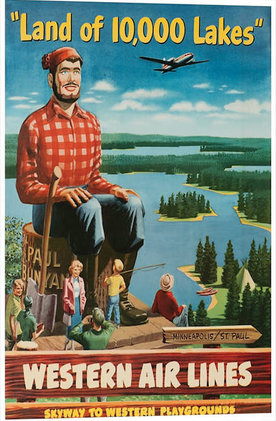 U.S. airlines lost more than $600 million in 1981, a year of
recession and government efforts to curb inflation – the interest rate on
mortgage loans averaged 17 percent that year.
To make their far-flung route offerings more efficient, airlines
increasingly embraced a hub-and-spoke system, with fleets of aircraft
concentrated at major airports that served as connecting points. The model
became the norm in the industry for large, networked airlines.
As the market forces of deregulation played out, Braniff Airlines
filed for bankruptcy in 1982 -- a move that indirectly led to the formation of
Sun Country Airlines in 1983.
Pictured: An ad from Western Airlines, which served MSP in the 1970s and 1980s. Western merged with Delta Air Lines in 1986.
Former
Braniff pilots came together to launch Sun Country with MSP as its home
base. MLT Vacations Inc., a Twin
Cities-based provider of flight-and-hotel packages, was a key financial backer.
The
charter airline performed well with flights to sunny destinations during
Minnesota’s cold-weather months. As Sun Country became more popular, other
airlines noticed the trend and competition increased. Sun Country’s original
owners put together a deal to sell the airline to Northwest in the mid-1980s,
but dissenting shareholders blocked the idea.
Sun
Country was eventually sold to B. John Barry, a banker, in 1988. By the early
1990s, Sun Country was the third largest charter airline in the U.S., aided in
large part by revenue from military charters during the first Gulf War.
|
Passenger
numbers continued to expand at MSP as the economy recovered from the early
1980s recession, and the MAC worked to meet demand for services. In 1984 a new
seven-level, $20 million parking ramp opened at Terminal 1 with 2,000 spaces.
The concession program at MSP continued to grow as well, with the first
McDonald’s opening in 1985.
That
fall, an eight-member search committee led by Carl Pohlad selected a group of
candidates to interview for the MAC’s executive director position. In November,
Jeff Hamiel, then 38 years old, was selected to lead the MAC, which at the time
had 250 employees.
Hamiel
had been hired in 1977 by Ray Glumack, the MAC’s former executive director.
Over the years Hamiel had held five different jobs at the MAC, the most recent
being deputy executive director.
Also
in 1985, an independent study of the airport predicted 29 million passengers by
2003, while passenger volume had totaled 11.5 million in 1983. The report
spurred renewed talk of the need for a new airport, farther from the Twin
Cities’ urban center.
The airport’s dual track planning process did not begin until 1989.
However, it actually had its roots in a decades-old lawsuit filed against the
MAC, leading to a 1985 Minnesota State Supreme Court decision.
 In Ario vs. MAC, the court’s decision in 1985 suggested there was
a class of about 27,500 property owners near the airport who might have a
common legal standing against the MAC, due to aircraft noise.
Pictured: A Sun Country Boeing 727 in the 1980s.
The court also found that a decline in the market value of homes
affected by airplane noise had not been proven.
With the Ario decision and continuing passenger growth at MSP as
the backdrop, in 1989 the Minnesota State Legislature passed the Metropolitan
Airport Planning Act, which became known as the “Dual Track Process.”
Essentially, the airport was directed to study whether the best
solution for the airport’s future – given the complaints about airplane noise
and anticipated growth in passenger numbers – was to either expand the existing
airport’s capacity, or build a new airport out beyond existing suburban
development.
|
Northwest
and Republic merge
Northwest Airlines and Republic Airlines
were both major operators at MSP in the 1980s. As Republic started pulling
domestic travelers away from Northwest, a former Republic executive approached
Northwest with what was called a “fish-buys-whale” idea.
The plan led eventually to Northwest
buying Republic for $884 million in 1986. The deal built up Northwest’s
domestic network and gave Republic fliers easier access to Northwest’s
international destinations. Northwest dropped the “Orient” from the end of its
name after the acquisition.
Republic’s four major hubs had been MSP, Detroit, Memphis and
Phoenix -- the first three of which would become the core of Northwest
Airline’s hub presence following the purchase. Republic also operated the
world’s largest fleet of DC-9s, an aircraft that would have a presence at MSP
for years to come.
With the acquisition, Northwest almost doubled in size at MSP and
became the unparalleled dominant carrier at MSP.
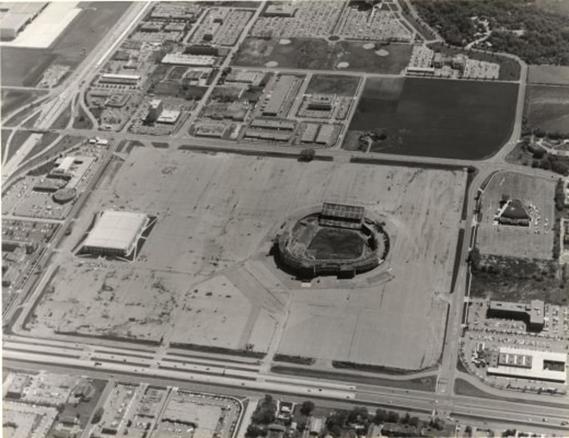 The 1980s saw changes on important parcels south of MSP Airport. Metropolitan Stadium was demolished in 1985. Met Center, the white-roof building, hung on until the North Stars left for Dallas in 1993. It was demolished in 1994, after the Mall of America had already opened next door in 1992. Cedar Avenue is at the bottom of this 1982 photo, which looks east.
Northwest
Airlines’ leveraged buyout
As the decade closed, the airline industry
had one more surprise for MSP.
The 1980s era of leveraged buyouts -- a
popular tool for private equity groups -- was near its end. But financiers
began eyeing Northwest Airline’s operations and it routes to Asia, which were
seen as under-valued.
Gary Wilson, a former NWA board member and Al Checchi (pictured below), a
former associate of the wealthy Bass family of Texas, had acquired about 5
percent of NWA stock and were planning a takeover involving a large debt-load.
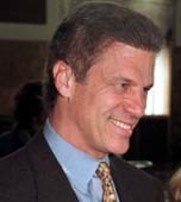 Marvin Davis, a billionaire real estate developer, was also making a move to acquire Northwest.
Ultimately, the Wilson-Checchi group prevailed, putting together a $3.65 billion leveraged buyout of Northwest. In September of 1989, Northwest CEO Steven Rothmeier and his team resigned, replaced by Checchi and a new management group.
In the early 1990s, the airline would negotiate with the MAC and the state of Minnesota on financial terms to keep Northwest in Minnesota and retain MSP as a key hub.
Sources: MAC archive materials. Minnesota State Historicial Society archives. Newspaper clips, Minneapolis StarTribune; other publications.
|
Get your tickets for
the 2018 State of the Airport Luncheon, happening Thursday, Sept. 20 at the new
InterContinental Hotel at MSP’s Terminal 1.
Brian Ryks, CEO and
executive director of the Metropolitan Airports Commission, will provide an
update on improvements underway at the airport. Ed Bastian, CEO of Delta Air
Lines, will provide comments via video, and Bill Lentsch, senior vice president
at Delta, will speak about MSP’s role as a critical hub for Delta 10 years
after its acquisition of Northwest Airlines.
All the details –
including how to purchase tickets – are available at this web page.
|
At the August 2018 MAC Board of Commissioners meeting, former
commissioners Pat Harris and James Hamilton were recognized for their many
years of service on the MAC Board.
Harris (pictured, right) was appointed to the board in 2006 by St. Paul Mayor Chris
Coleman and served for more than 11 years, making him one of the
longest-serving commissioners in MAC history.
|
|
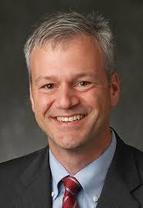 |
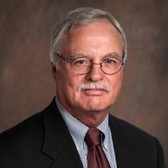 |
|
James Hamilton (pictured, left) was appointed by Minnesota Gov. Mark Dayton in 2013, and was an advocate for local operators of concessions at MSP Airport. |
Tuesday, Sept. 4 – MAC committee meetings.
Monday, Sept. 17 – Full MAC board meeting.
Materials for these meetings are posted on the MAC’s meeting website three days prior to
meeting dates.
Board Meetings
Business Opportunities
Career Opportunities
General Aviation Airport Information
MSP Aircraft Noise Information
MSP Airport
|